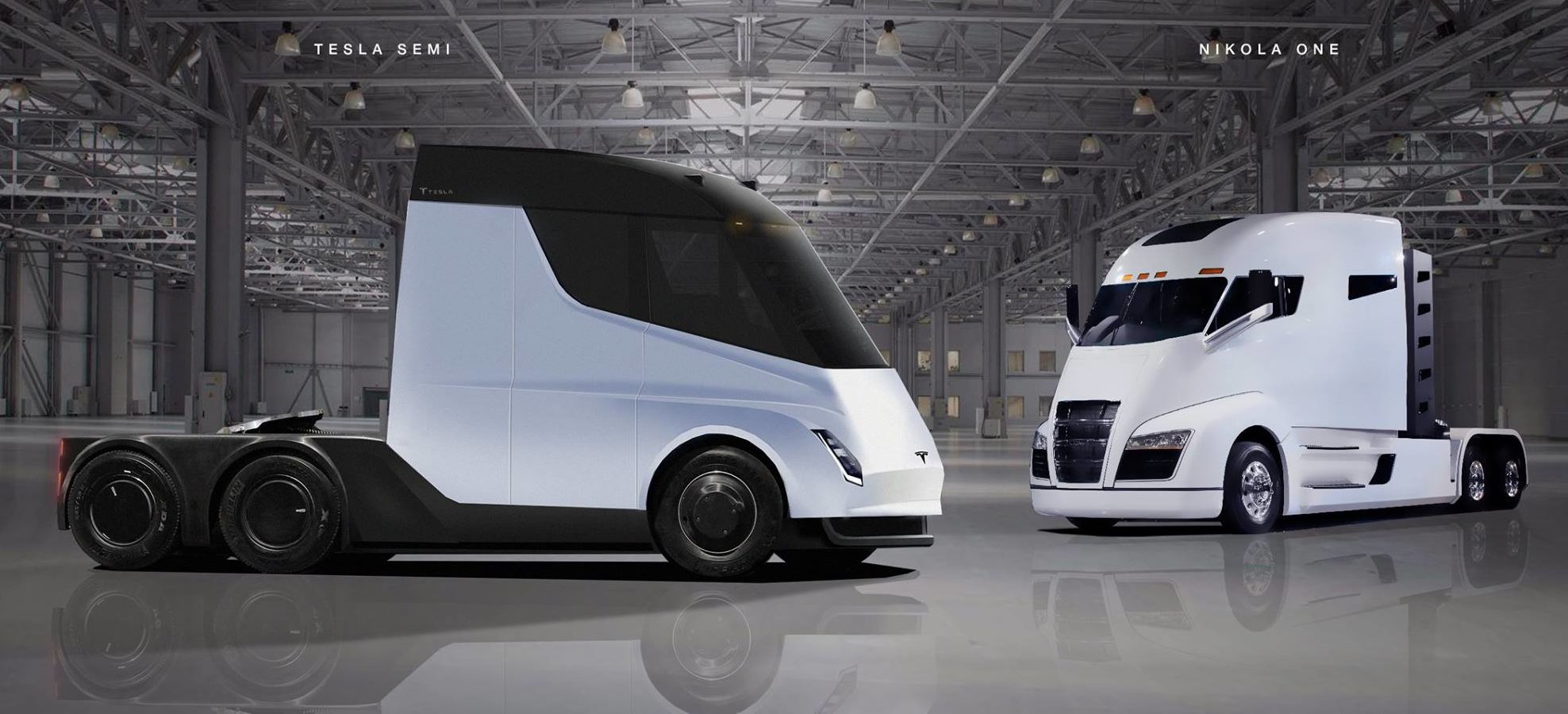
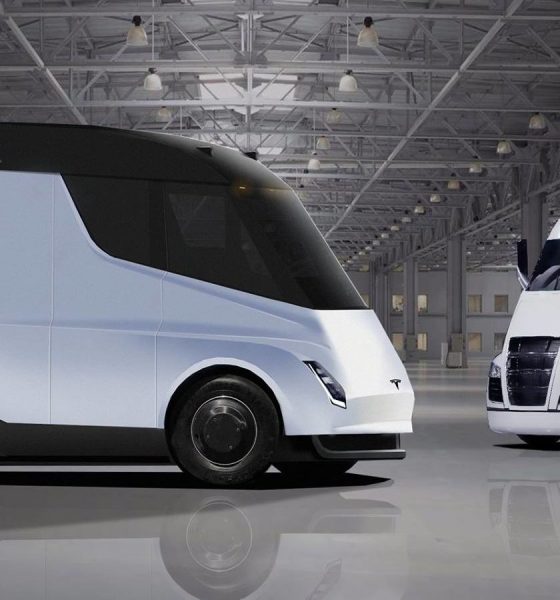
News
Tesla Semi lawsuit drags on with small victory for Nikola Motor
Almost two years ago, Nikola Motors surprised the trucking market by filing a $2 billion lawsuit alleging that the Tesla Semi copied several design elements from the Nikola One, the truck-maker’s flagship hydrogen long hauler. News about the patent lawsuit has been scarce for over a year, but recent updates indicate that Nikola has snatched a small victory from the Silicon Valley-based electric car maker.
Nikola’s case listed several characteristics of the One that were allegedly copied by Tesla. These included the Semi’s wraparound windshield, mid-entry door, front fenders, and the all-electric truck’s aerodynamic shape. To highlight its point, Nikola stated that the similar drag coefficients between the One (0.37) and the Semi (0.36) was further proof that the battery electric long hauler was copied from the hydrogen fuel-cell sleeper cab.
Excerpts from Nikola’s lawsuit pointed out that the Semi’s design had caused confusion among the One’s customers, diverting sales from the hydrogen truck maker to Tesla. Nikola also argued that these confusions might result in the Semi’s problems being attributed to the One, such as those resulting from Tesla’s batteries and Autopilot software. These, according to Nikola, are causing damage to its brand.
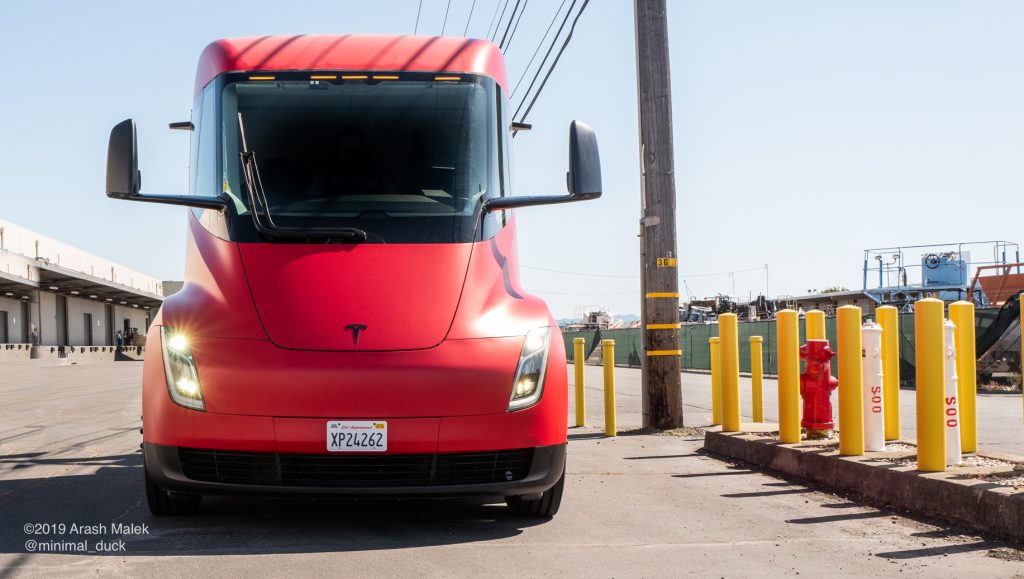
“Tesla has had problems with its batteries starting fires and its autonomous features causing fatal accidents. Should these problems arise with the Tesla Semi, the market will attribute these problems to Nikola because of the similarities between the two vehicles. Customers will also impute the Tesla Semi’s limitations (distance and charging time) to Nikola, which will make Nikola’s product less appealing to customers,” the hydrogen truck maker noted in its complaint.
Unfortunately for Nikola, cases that are centered on design patents are very difficult to prove. This point was especially highlighted in August 2018 when the US Patent Office awarded Tesla a pair of design patents for the Semi that actually listed the Nikola One as a reference, which meant that the examiner deemed Tesla’s design as unique. For Nikola to win its case against Tesla, it would have to prove that the US Patent Examiner made a mistake when comparing the Semi and the One’s designs, and that’s a very difficult point to argue.
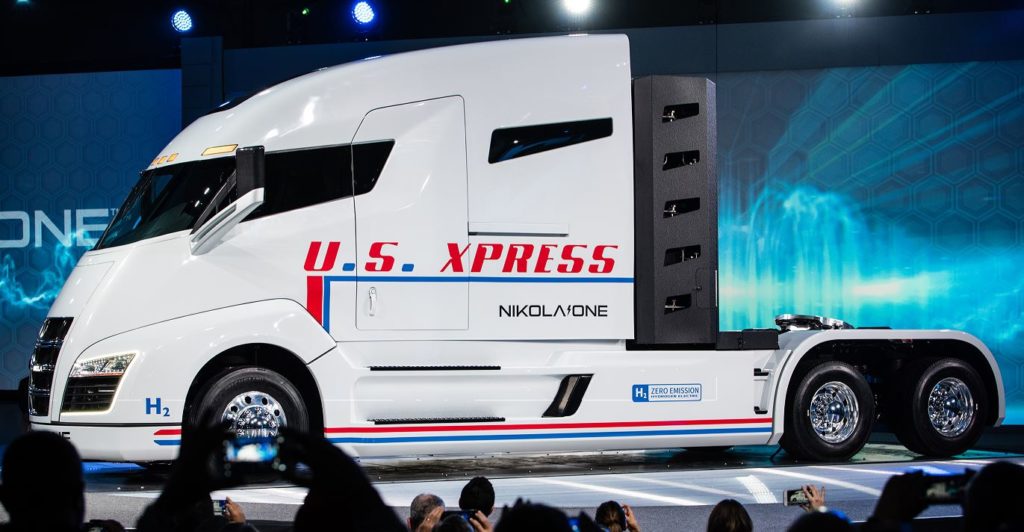
Yet if recent tweets from Nikola CEO Trevor Milton are any indication, it appears that the hydrogen truck maker has stood by its lawsuit against Tesla. As it turned out, Tesla had filed a request with the Patent Trial and Appeal Board in September 2019 asking for a review to invalidate Nikola’s side door patent for the One. This request seems to have failed. Granted, it is a very small victory for Nikola, considering that it is fighting an incredibly steep uphill battle. Still, the dismissal of Tesla’s effort is a victory for the hydrogen truck maker nonetheless.
“Tesla loses bid to invalidate @nikolamotor patents in USPTO dispute. USPTO not only upheld Nikola semi truck important patents but refused Tesla’s ask to modify our patents. Two billion-dollar lawsuit moving forward. We will defend our company’s IP no matter who it is,” Milton wrote on Twitter.
In a statement to Forbes, Nikola Chief Legal Officer Britton Worthen lauded the decision, stating that the development was “obviously favorable” and that the company believes the matter was “decided correctly.” Tesla, for its part, has declined to comment. That being said, a Tesla spokesperson has noted in the past that “It’s patently obvious there is no merit to this lawsuit.” Elon Musk does not seem to be bothered by the suit either, noting in a previous earnings call that the entire situation is a case of fate loving irony.
Ultimately, the Nikola One may very well be beaten to the market by the Tesla Semi. While the One was unveiled prior to Tesla’s all-electric truck, prototypes of the Semi have been conducting real-world testing since the vehicles were unveiled. Recent sightings of the all-electric trucks suggest that the vehicles are now being tested in harsh conditions. This hints that Tesla may actually be on track to start early production runs of the Semi sometime later this year, as hinted at by the company in the past. Nikola, for its part, seems to be on track to release the Nikola Two, a shorter-range, battery electric truck, before the One. The company expects to start production of its trucks next year.

News
Man credits Grok AI with saving his life after ER missed near-ruptured appendix
The AI flagged some of the man’s symptoms and urged him to return to the ER immediately and demand a CT scan.

A 49-year-old man has stated that xAI’s Grok ended up saving his life when the large language model identified a near-ruptured appendix that his first ER visit dismissed as acid reflux.
After being sent home from the ER, the man asked Grok to analyze his symptoms. The AI flagged some of the man’s symptoms and urged him to return immediately and demand a CT scan. The scan confirmed that something far worse than acid reflux was indeed going on.
Grok spotted what a doctor missed
In a post on Reddit, u/Tykjen noted that for 24 hours straight, he had a constant “razor-blade-level” abdominal pain that forced him into a fetal position. He had no fever or visible signs. He went to the ER, where a doctor pressed his soft belly, prescribed acid blockers, and sent him home.
The acid blockers didn’t work, and the man’s pain remained intense. He then decided to open a year-long chat he had with Grok and listed every detail that he was experiencing. The AI responded quickly. “Grok immediately flagged perforated ulcer or atypical appendicitis, told me the exact red-flag pattern I was describing, and basically said “go back right now and ask for a CT,” the man wrote in his post.
He copied Grok’s reasoning, returned to the ER, and insisted on the scan. The CT scan ultimately showed an inflamed appendix on the verge of rupture. Six hours later, the appendix was out. The man said the pain has completely vanished, and he woke up laughing under anesthesia. He was discharged the next day.
How a late-night conversation with Grok got me to demand the CT scan that saved my life from a ruptured appendix (December 2025)
byu/Tykjen ingrok
AI doctors could very well be welcomed
In the replies to his Reddit post, u/Tykjen further explained that he specifically avoided telling doctors that Grok, an AI, suggested he get a CT scan. “I did not tell them on the second visit that Grok recommended the CT scan. I had to lie. I told them my sister who’s a nurse told me to ask for the scan,” the man wrote.
One commenter noted that the use of AI in medicine will likely be welcomed, stating that “If AI could take doctors’ jobs one day, I will be happy. Doctors just don’t care anymore. It’s all a paycheck.” The Redditor replied with, “Sadly yes. That is what it felt like after the first visit. And the following night could have been my last.”
Elon Musk has been very optimistic about the potential of robots like Tesla Optimus in the medical field. Provided that they are able to achieve human-level articulation in their hands, and Tesla is able to bring down their cost through mass manufacturing, the era of AI-powered medical care could very well be closer than expected.
News
Tesla expands Model 3 lineup in Europe with most affordable variant yet
The Model 3 Standard still delivers more than 300 miles of range, potentially making it an attractive option for budget-conscious buyers.

Tesla has introduced a lower-priced Model 3 variant in Europe, expanding the lineup just two months after the vehicle’s U.S. debut. The Model 3 Standard still delivers more than 300 miles (480 km) of range, potentially making it an attractive option for budget-conscious buyers.
Tesla’s pricing strategy
The Model 3 Standard arrives as Tesla contends with declining registrations in several countries across Europe, where sales have not fully offset shifting consumer preferences. Many buyers have turned to options such as Volkswagen’s ID.3 and BYD’s Atto 3, both of which have benefited from aggressive pricing.
By removing select premium finishes and features, Tesla positioned the new Model 3 Standard as an “ultra-low cost of ownership” option of its all-electric sedan. Pricing comes in at €37,970 in Germany, NOK 330,056 in Norway, and SEK 449,990 in Sweden, depending on market. This places the Model 3 Standard well below the “premium” Model 3 trim, which starts at €45,970 in Germany.
Deliveries for the Standard model are expected to begin in the first quarter of 2026, giving Tesla an entry-level foothold in a segment that’s increasingly defined by sub-€40,000 offerings.
Tesla’s affordable vehicle push
The low-cost Model 3 follows October’s launch of a similarly positioned Model Y variant, signaling a broader shift in Tesla’s product strategy. While CEO Elon Musk has moved the company toward AI-driven initiatives such as robotaxis and humanoid robots, lower-priced vehicles remain necessary to support the company’s revenue in the near term.
Reports have indicated that Tesla previously abandoned plans for an all-new $25,000 EV, with the company opting to create cheaper versions of existing platforms instead. Analysts have flagged possible cannibalization of higher-margin models, but the move aims to counter an influx of aggressively priced entrants from China and Europe, many of which sell below $30,000. With the new Model 3 Standard, Tesla is reinforcing its volume strategy in Europe’s increasingly competitive EV landscape.
News
Tesla FSD (Supervised) stuns Germany’s biggest car magazine
FSD Supervised recognized construction zones, braked early for pedestrians, and yielded politely on narrow streets.
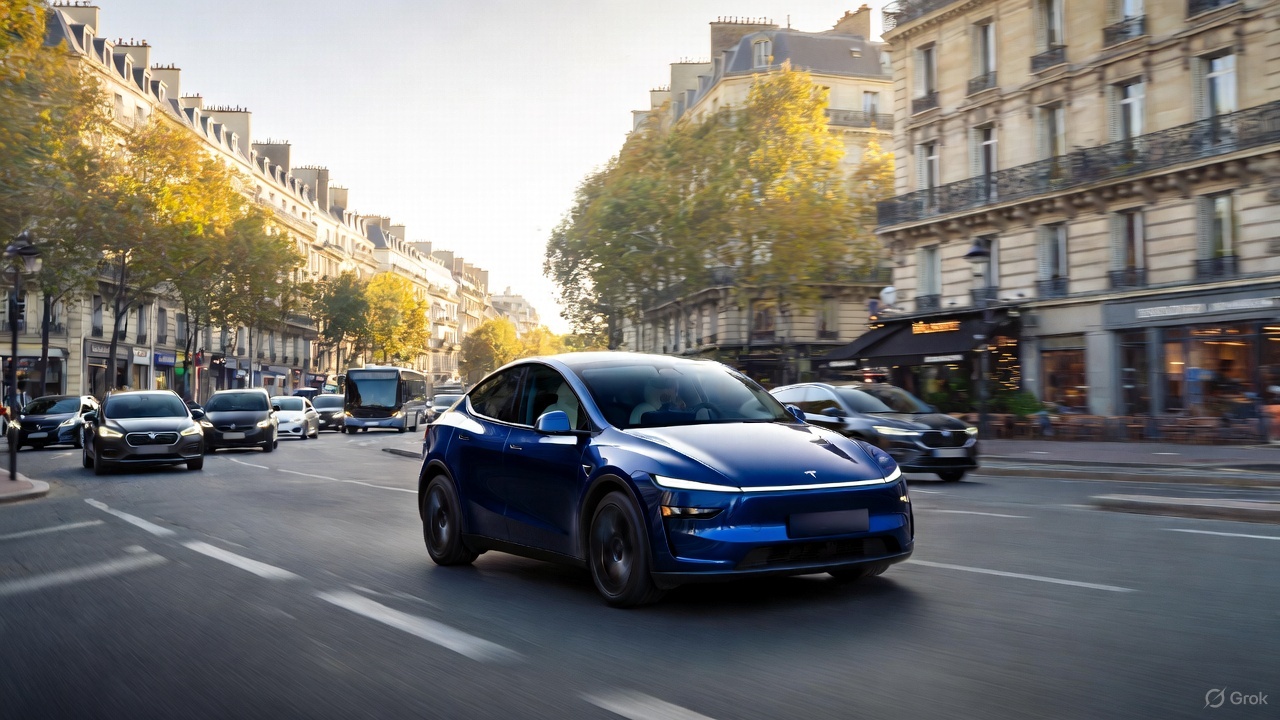
Tesla’s upcoming FSD Supervised system, set for a European debut pending regulatory approval, is showing notably refined behavior in real-world testing, including construction zones, pedestrian detection, and lane changes, as per a recent demonstration ride in Berlin.
While the system still required driver oversight, its smooth braking, steering, and decision-making illustrated how far Tesla’s driver-assistance technology has advanced ahead of a potential 2026 rollout.
FSD’s maturity in dense city driving
During the Berlin test ride with Auto Bild, Germany’s largest automotive publication, a Tesla Model 3 running FSD handled complex traffic with minimal intervention, autonomously managing braking, acceleration, steering, and overtaking up to 140 km/h. It recognized construction zones, braked early for pedestrians, and yielded politely on narrow streets.
Only one manual override was required when the system misread a converted one-way route, an example, Tesla stated, of the continuous learning baked into its vision-based architecture.
Robin Hornig of Auto Bild summed up his experience with FSD Supervised with a glowing review of the system. As per the reporter, FSD Supervised already exceeds humans with its all-around vision. “Tesla FSD Supervised sees more than I do. It doesn’t get distracted and never gets tired. I like to think I’m a good driver, but I can’t match this system’s all-around vision. It’s at its best when both work together: my experience and the Tesla’s constant attention,” the journalist wrote.
Tesla FSD in Europe
FSD Supervised is still a driver-assistance system rather than autonomous driving. Still, Auto Bild noted that Tesla’s 360-degree camera suite, constant monitoring, and high computing power mark a sizable leap from earlier iterations. Already active in the U.S., China, and several other regions, the system is currently navigating Europe’s approval pipeline. Tesla has applied for an exemption in the Netherlands, aiming to launch the feature through a free software update as early as February 2026.
What Tesla demonstrated in Berlin mirrors capabilities already common in China and the U.S., where rival automakers have rolled out hands-free or city-navigation systems. Europe, however, remains behind due to a stricter certification environment, though Tesla is currently hard at work pushing for FSD Supervised’s approval in several countries in the region.








